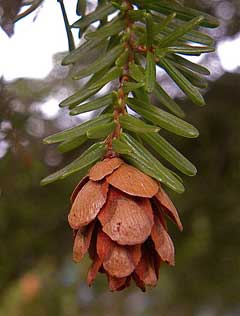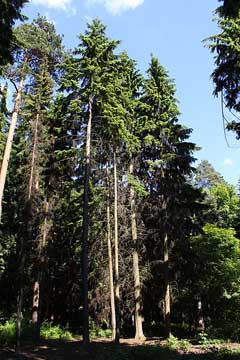 |
|
flickr.com/photos/28435100@N00 |
 |
| commons.wikimedia.org/wiki/User:Crusier |
Translate this page:
Summary
Bloom Color: Green, Yellow. Main Bloom Time: Early spring, Late spring, Mid spring. Form: Pyramidal.
Physical Characteristics

 Tsuga heterophylla is an evergreen Tree growing to 70 m (229ft) by 15 m (49ft) at a fast rate.
Tsuga heterophylla is an evergreen Tree growing to 70 m (229ft) by 15 m (49ft) at a fast rate.
See above for USDA hardiness. It is hardy to UK zone 6. It is in leaf all year, in flower from April to May, and the seeds ripen from October to November. The species is monoecious (individual flowers are either male or female, but both sexes can be found on the same plant) and is pollinated by Wind.
Suitable for: light (sandy), medium (loamy) and heavy (clay) soils and prefers well-drained soil. Suitable pH: mildly acid, neutral and basic (mildly alkaline) soils and can grow in very acid soils.
It can grow in full shade (deep woodland) semi-shade (light woodland) or no shade. It prefers moist soil.
UK Hardiness Map
US Hardiness Map
Synonyms
T. albertiana.
Plant Habitats
Woodland Garden Canopy; Hedge;
Edible Uses
Edible Parts: Inner bark Shoots
Edible Uses: Condiment Gum Tea
Inner bark - raw or cooked[213, 257]. It can be dried, ground into a powder and then used as a thickening in soups etc or mixed with cereals when making bread[161]. It has also been used as a sweetener for other foods[257]. The inner bark was often cooked and then dried for use in the winter[256]. At its best in spring[172], it was one of the staple foods of the Alaskan Indians[82]. An emergency food, it is only used when all else fails[183]. The leaves and twigs yield 'spruce oil', used commercially to flavour chewing gum, soft drinks, ice cream etc[183]. Pitch, obtained from crevices in the bark, has been chewed as a gum[257]. The leaves and young shoots have been chewed as an emergency food to keep one alive when lost in the woods[257]. A herbal tea is made from the leaves and shoot tips[172, 183]. These tips are also an ingredient of 'spruce beer'[183].
References More on Edible Uses
Medicinal Uses
Plants For A Future can not take any responsibility for any adverse effects from the use of plants. Always seek advice from a professional before using a plant medicinally.
Astringent Diaphoretic Diuretic Parasiticide Poultice Skin
Western hemlock was commonly employed medicinally by several native North American Indian tribes who used it to treat a variety of complaints[257]. It is little, if at all, used in modern herbalism. The bark is astringent, diaphoretic and diuretic[21]. A decoction of the pounded bark has been used in the treatment of haemorrhages, tuberculosis and syphilis[257]. The boiled bark, combined with liquorice fern (Polypodium glyccyrhiza), has been used in the treatment of haemorrhages[257]. An infusion of the inner bark or twigs is helpful in the treatment of kidney or bladder problems[21]. It can also be used as a good enema for treating diarrhoea and as a gargle or mouthwash for mouth and throat problems[21]. Externally, it can be used as a wash on sores and ulcers[21, 257]. A poultice of the plant has been applied to bleeding wounds[257]. A moxa of the twigs has been used to get rid of warts[257]. The powdered bark can be put into shoes for tender or sweaty feet or for foot odour[21]. The gum obtained from the trunk has been applied to cuts[257]. It has been applied to the skin to prevent chapping and sunburn[257]. A poultice of the chewed leaves has been used in the treatment of burns[257].
References More on Medicinal Uses
The Bookshop: Edible Plant Books
Our Latest books on Perennial Plants For Food Forests and Permaculture Gardens in paperback or digital formats.

Edible Tropical Plants
Food Forest Plants for Hotter Conditions: 250+ Plants For Tropical Food Forests & Permaculture Gardens.
More

Edible Temperate Plants
Plants for Your Food Forest: 500 Plants for Temperate Food Forests & Permaculture Gardens.
More

More Books
PFAF have eight books available in paperback and digital formats. Browse the shop for more information.
Shop Now
Other Uses
Dye Fuel Gum Hedge Hedge Parasiticide Resin Rust Tannin Wood
Yields a resin similar to Abies balsamea, it is gathered by incisions in the trunk or by boiling the wood[46, 61, 64]. The bark contains 8 - 18% tannin and is a major source of tannin in America[46, 82, 171, 226]. A reddish-brown dye is obtained from the bark[21, 46, 257]. A decoction of the bark has been used to clean rust off iron and steel[257]. A pitch (called hemlock pitch), is obtained by distillation of the young branches[46]. The pitch is rubbed on the hair to get rid of head lice[257]. Tolerant of light trimming, plants can be grown as a hedge[81]. This species makes a good hedge in Britain[124, 200]. Wood - light, hard, tough, easy to work. Commercially superior to other members of this genus, it is an important tree for construction, the outside of buildings etc and for carving into spoons etc[46, 61, 82, 171, 226, 229]. It is also a major source of pulp[226]. The wood makes a slow-burning fuel and so can be used to bank up a fire to keep it burning overnight[257].
Special Uses
Hedge Hedge
References More on Other Uses
Cultivation details
Landscape Uses:Hedge, Aggressive surface roots possible, Screen, Specimen, Woodland garden. An easily grown plant, it thrives best when growing in a deep well-drained soil in the western parts of Britain where it appreciates the higher rainfall[11]. However, it succeeds in most soils and positions, being especially good on acidic sandy soils[81] but also tolerating some lime[11] so long as there is plenty of humus in the soil[208]. Plants are very shade tolerant when young, but need more sunlight as they grow older[81, 200]. Plants are thin and poor when grown in dry or exposed places[200]. Occasionally cultivated for its timber in Britain, it can grow 60 - 150cm per year[11, 185]. New growth takes place from mid-May to mid-September, at first it hangs downwards but begins to straighten towards the end of the season[185]. There are trees more than 50 metres tall in Britain[200]. Trees live for several centuries in the wild and often produce large quantities of seed[229]. Plants often form pure stands and cast a dense shade, thus preventing the regeneration of other trees whilst being able to reproduce itself[226]. Plants in this genus are notably resistant to honey fungus[200]. Special Features:North American native, Inconspicuous flowers or blooms.
References Carbon Farming Information and Carbon Sequestration Information
Temperature Converter
Type a value in the Celsius field to convert the value to Fahrenheit:
Fahrenheit:
The PFAF Bookshop
Plants For A Future have a number of books available in paperback and digital form. Book titles include Edible Plants, Edible Perennials, Edible Trees,Edible Shrubs, Woodland Gardening, and Temperate Food Forest Plants. Our new book is Food Forest Plants For Hotter Conditions (Tropical and Sub-Tropical).
Shop Now
Plant Propagation
Seed - it germinates better if given a short cold stratification[80, 113] and so is best sown in a cold frame in autumn to late winter. It can also be sown in early spring, though it might not germinate until after the next winter. If there is sufficient seed, an outdoor sowing can be made in spring[78]. Pot-grown seedlings are best potted up into individual pots once they are large enough to handle - grow them on in a cold frame and plant them out in early summer of the following year. Trees transplant well when they are up to 80cm tall, but they are best put in their final positions when they are about 30 - 45 cm or less tall, this is usually when they are about 5 - 8 years old[200]. Larger trees will check badly and hardly put on any growth for several years. This also badly affects root development and wind resistance[200].
Other Names
If available other names are mentioned here
Native Range
NORTHERN AMERICA: United States (Alaska (south), Idaho (north), Montana (northwest), Oregon (west), Washington, California (northwest)), Canada (Alberta (west), British Columbia)
Weed Potential
Right plant wrong place. We are currently updating this section.
Please note that a plant may be invasive in one area but may not in your area so it's worth checking.
Conservation Status
IUCN Red List of Threatened Plants Status :

Growth: S = slow M = medium F = fast. Soil: L = light (sandy) M = medium H = heavy (clay). pH: A = acid N = neutral B = basic (alkaline). Shade: F = full shade S = semi-shade N = no shade. Moisture: D = dry M = Moist We = wet Wa = water.
Now available:
Food Forest Plants for Mediterranean Conditions
350+ Perennial Plants For Mediterranean and Drier Food Forests and Permaculture Gardens.
[Paperback and eBook]
This is the third in Plants For A Future's series of plant guides for food forests tailored to
specific climate zones. Following volumes on temperate and tropical ecosystems, this book focuses
on species suited to Mediterranean conditions—regions with hot, dry summers and cool, wet winters,
often facing the added challenge of climate change.
Read More
Expert comment
Author
(Raf.)Sarg.
Botanical References
1160200
Links / References
For a list of references used on this page please go here
Readers comment